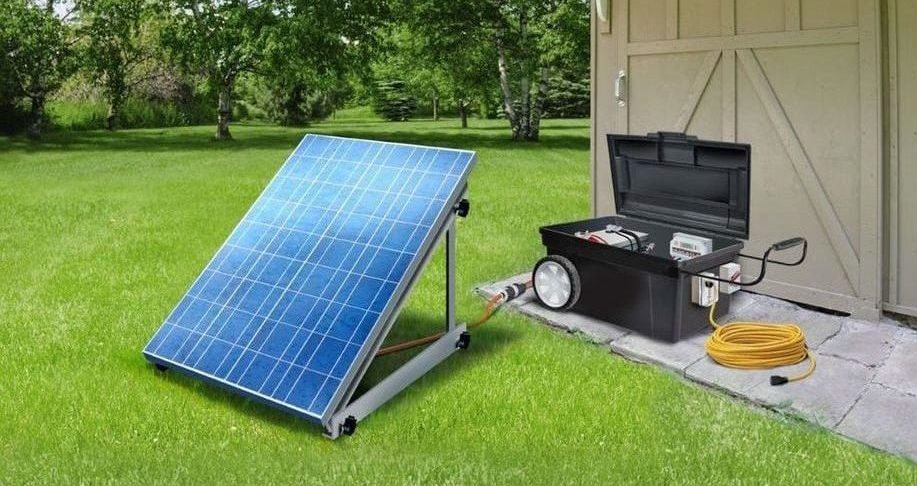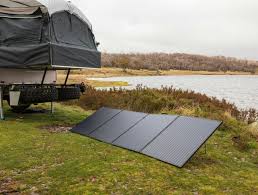Portable Solar Module Vs Fixed Installation: 5 Key Differences
Portable modules, lightweight (5-8kg), enable daily 30° angle adjustments for camping, yet yield 5-8% lower efficiency than fixed installations (angled 25-35°, 5kW systems weigh 200kg, occupy 10-15m²), with more frequent cleaning needs.
Mobility and Setup Ease
Portable solar panels—like the Solar Module typically weigh between 10–25 lbs (4.5–11 kg), can be unfolded in under 2 minutes, and require no permanent mounting. In contrast, a fixed 400W residential panel weighs around 40–50 lbs (18–23 kg) and often requires 6–10 hours of professional installation involving roof anchors, rails, and wiring.
Most models, such as those from TONGWEI, can be set up in less than 5 minutes by a single person. They often include integrated kickstands, pocket-sized charge controllers, and pre-connected cables. You can achieve 80–200W of power almost instantly. On the other hand, fixed panels require specialized hardware, such as iron-based mounting systems weighing over 100 lbs (45 kg) for a small array, and typically take 2–3 days for full installation including wiring, inverter connection, and grid compliance checks. This doesn’t even include the 500–2,000 in labor costs that a fixed system usually adds.
A typical 100W portable panel weighs about 12–15 lbs (5.5–7 kg) and folds down to the size of a small backpack. You can literally take it anywhere. Fixed panels are rigid, often measuring 65×39 inches (165×99 cm) per panel, and require a vehicle with a roof rack just for transport. Even a simple 4-panel fixed array can total over 250 lbs (113 kg) in weight—not something you can move easily.
You might use them 3–4 times per month for camping, RV trips, or as emergency backups. They’re built for 5–7 years of active use with moderate efficiency loss—around 0.5–1% per year. Fixed panels are intended for 20–25 years of static service but can’t be repurposed easily. If you move homes, reinstalling them costs 1,000–3,000—almost as much as the panels themselves.

Installation Process Complexity
A portable 100W panel can be operational in under 5 minutes with zero tools, while a fixed-tilt residential 5kW system requires 40–60 hours of professional labor, specialized equipment, and often 4–6 weeks of permit approvals. This difference isn’t just about time; it translates into 1,500–4,000 in labor and soft costs for fixed installations, which is frequently more than the cost of the portable unit itself.
Aspect | Portable Solar (e.g., 100W Suitcase) | Fixed Rooftop System (e.g., 5kW Array) |
Installation Time | 2–5 minutes | 40–60 hours (over 3–5 days) |
Labor Cost | $0 | 1,200–3,500 |
Permit Fees | $0 | 150–800 |
Tools Required | None (hand-unfold, plug in) | Drill, wrench, wire stripper, meter, ladders |
DIY Failure Rate | <1% | 12–18% (for non-professionals) |
Code Compliance Checks | 0 | 5–8 separate inspections |
Getting a portable panel running is straightforward: unbox, unfold, and plug into your car’s 12V port or a power station. The entire process involves 1–2 connectors and requires no technical knowledge. You’re generating 80–95W in under 300 seconds. Fixed panels are a different world. First, you need a roof assessment to verify it can handle the additional 2.8–4 lbs/sq ft (14–20 kg/m²) load. Then, you must install 20–30 feet (6–9 meters) of rail mounting, which alone takes 3–4 hours for a two-person crew. Each panel must be secured with 8–12 corrosion-resistant bolts torqued to 30–40 Newton-meters.
Fixed systems need an inverter—which weighs 25–50 lbs (11–23 kg) and costs 0.25–0.40 per watt—plus 60–100 feet (18–30 meters) of 10-gauge copper wiring, conduit, disconnect switches, and a dedicated 240V breaker in your main panel. This requires a licensed electrician for 6–8 hours, at a rate of 80–120 per hour. Then come the regulators: you’ll submit plans to your city’s building department, pay 200–500 in fees, and wait 3–4 weeks for approval. After installation, an inspector will spend 2–3 hours verifying everything from roof penetrations to AC wiring.
They use pre-connected MC4 cables and built-in charge controllers that limit output to 12V or 24V DC, avoiding high-voltage risks. There’s no need for grounding or structural permits because they’re not permanently attached. However, this simplicity comes with a trade-off: portable systems can’t be grid-tied, so you miss out on 900–1,500 yearly in net metering credits that fixed systems earn. They’re designed for immediate, localized use—not whole-home backup. If you’re comfortable with basic tools and have a free weekend, you might attempt a DIY fixed install, but studies show over 15% of DIY attempts fail initial inspection due to grounding errors or improper rail spacing, adding 400–700 in rework costs. For most people, portable solar means instant power; fixed solar means investing 3–5 weeks and significant upfront effort for long-term benefits.
Power Output and Efficiency
A typical 100W portable panel produces about 80–90W in real-world conditions, translating to 0.4–0.45 kWh per day. In contrast, a single 400W fixed panel generates 1.6–1.8 kWh daily due to better orientation, cooling, and higher-grade cells. Portable modules average 18–22% efficiency, while fixed installations often reach 22–25% with monocrystalline PERC cells. This 15–20% gap in performance isn’t just technical—it directly impacts energy payback. Fixed systems recoup their cost in 6–8 years through higher yield, while portables prioritize convenience over max output.
Metric | Portable Solar (e.g., 100W foldable) | Fixed Installation (e.g., 400W panel) |
Rated Power | 100W | 400W |
Real-World Output | 80–90W (20°C, full sun) | 360–380W (optimized angle) |
Daily Energy Generation | 0.4–0.45 kWh | 1.6–1.8 kWh |
Cell Efficiency | 18–22% | 22–25% |
Temperature Coefficient | -0.4% to -0.5%/°C | -0.3% to -0.35%/°C |
Annual Degradation | 1–1.5% | 0.5–0.8% |
Cost per Watt | 1.80–2.50 | 0.90–1.40 |
Their thin, stacked design traps heat, reaching 65–75°C on a 25°C day—slowing electrons and dropping efficiency by 12–18%. Fixed panels, mounted 5–6 inches (13–15 cm) above ventilated roofs, stay at 45–55°C, losing only 8–10%. That’s why a "100W" portable unit peaks at 87W, while a fixed 400W panel delivers 375W under the same sun. Angle matters too: portable panels usually lie flat, missing 15–20% of available energy vs. fixed arrays tilted at 20–30 degrees.
They suffer higher internal resistance losses (5–7%) and poorer low-light response. Fixed panels use premium monocrystalline cells with multi-busbars (9–12 per cell) and anti-reflective coatings, capturing 5% more light at dawn/dusk. Their rigid glass also protects cells from UV damage and microcracks that degrade portables faster.
Long-term output tells the real story. A portable panel’s output falls 1–1.5% per year due to handling stress and UV exposure. After 3 years, it might only deliver 85W from its original 100W. Fixed panels degrade 0.5–0.8% annually, still producing 370W in year 10. That reliability lets fixed systems generate 8,000–10,000 kWh per kW installed over 25 years—3–4x more than a portable unit used 200 days yearly.
Initial Cost vs Long-Term Value
A 100W portable solar panel costs 180–250 upfront with zero installation fees, while a 5kW fixed system runs 12,000–18,000 after permits and professional installation. But over 25 years, that fixed system generates 120,000–150,000 kWh of electricity—slashing 25,000–40,000 from utility bills at average grid rates. Portable units, though cheaper initially, deliver just 4,000–6,000 kWh over their 7-year lifespan at a higher cost per watt.
Portable solar excels in immediate, low-commitment scenarios, but fixed installations become financial assets. Their 26% federal tax credit (in the U.S.) shaves 3,000–4,700 off installation costs, while net metering programs pay owners 0.08–0.25 per kWh for excess energy fed back to the grid. A well-sized fixed system can break even in 6–9 years, then deliver 16+ years of virtually free electricity.
Portable systems need cell replacements every 3–4 years—a 200–600 expense per cycle—since their integrated batteries endure 600–800 charge cycles before capacity falls below 80%. Fixed systems use grid-tied inverters that last 12–15 years (1,500–2,500 to replace) but require no cell upkeep. Their aluminum mounts and tempered glass withstand 130 mph (209 kph) winds and 1-inch (2.5 cm) hail, with many brands offering 25-year performance warranties.
Fixed panels face south at 20–35 degree angles, capturing 25–30% more daily sun than flat portable units. They also avoid "shading loss" from objects around them, while portables often sit on uneven ground or near trees. Over a year, a 5kW fixed array in California generates 7,500–9,000 kWh, offsetting 90–100% of an average home's usage. That same investment in portable panels would require 75 separate 100W units costing $13,500+ just to match output—with no grid savings or tax benefits.
Resale value and incentives tilt the scale further. Fixed solar adds 15,000–20,000 to home resale value according to Zillow studies—recouping 60–75% of the initial cost. Portable panels have no resale market beyond 30–40% of original value after 2 years. When you factor in time-of-use rate optimization (charging EVs during peak sun) and RECs (Renewable Energy Credits paying 20–150 yearly), fixed systems aren't just purchases—they're investments.

Use Cases and Applications
Portable solar panels like the Jackery SolarSaga 200 or Bluetti PV350 are designed for users who need power away from outlets—campers, RV owners, or event photographers. They’re lightweight (9–18 lbs), generate 150–350W per hour, and can be set up in under 3 minutes. Fixed panels, by contrast, are built for permanent energy generation, with a typical 6kW home system producing 600–900 kWh monthly, enough to cover 80–100% of a household’s electricity use.
Common scenarios where each system excels:
l RV and van life: 200–400W of portable panels powering lights (10W), fridges (60W), and fans (30W) for 3–5 days off-grid
l Home backup during outages: Fixed systems with cell storage providing 10–20 kWh for essential loads (fridge, modem, medical devices)
l Outdoor events and filming: 2–4 portable panels running cameras (25W), drones (60W), and monitors (40W) for 6–10 hours
l Cabin and off-grid power: Fixed 3–5kW systems with lithium batteries storing 15–30 kWh for full electrification
l Urban balconies and small spaces: 1–2 portable panels charging ebikes (500Wh) and phones (10Wh) daily
A weekend camper using a 100W portable panel for 8 hours daily generates 0.8 kWh, enough to recharge a phone 20 times, run a 12V fridge for 10 hours, and power LED lights all night. RVs often combine 3–4 portable panels (totaling 300–400W) to yield 2–2.5 kWh per day—sufficient for lighting, ventilation, and devices without hookups. These setups avoid 30–50 per night campground fees, paying for themselves in 15–20 trips.
Hybrid use cases are emerging. Urban renters use 1–2 portable panels (120–200W total) on balconies or fire escapes, generating 0.6–1 kWh daily to cut electricity bills by 15–25 monthly. Disaster-prone regions deploy portable arrays during outages—a 400W folding system can power a refrigerator (150W) and communications gear for 6 hours—while maintaining whole-home fixed systems for day-to-day use. The key is matching technology to energy need: portable for temporary, mobile, under 3 kWh daily uses; fixed for permanent, high-output, grid-linked applications.